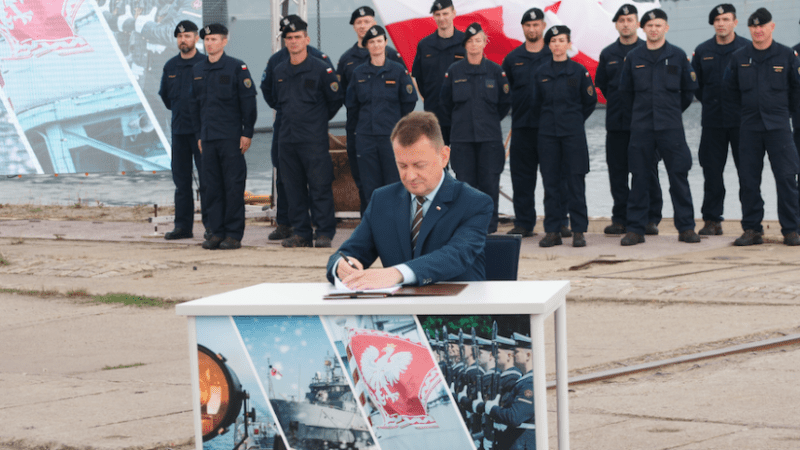Poland Signs Agreement for Miecznik Frigates

Today, in Gdynia, Head of the Polish MoD, Mariusz Błaszczak approved the agreement concluded by and between the Armament Inspectorate and a shipbuilding consortium led by the PGZ Group, created to pursue the Miecznik frigates programme. The consortium, alongside the PGZ Group, also involves the PGZ SW shipbuilding facility, as well as the Remontowa Holding shipbuilding group. This is the first stage of development work that would be aimed at analyzing three warship designs submitted by foreign bidders. The final selection is scheduled to take place in late 2021/early 2022.
Błaszczak would like the new vessels to be built "as quickly as the Kormoran II MCMVs". The building process is to be efficient - because MCMVs have displacements of less than 1,000 tonnes, being several times smaller than the upcoming frigates. "These vessels, with firepower, individually, comparable to the Naval Missile Unit squadron, with the safety, security, protection, air defence capabilities being comparable to a Wisła (IBCS/Patriot - ed.) system battery", Błaszczak noted, pointing out that vessel as such should be viewed as a major force in the Baltic Sea.
We are acquiring a capability to strike land, naval, and air targets, said Mjr Krzysztof Płatek, Armament Inspectorate spokesman. He added that the new vessels would be able to become a part of the net-centric battlespace, being capable of working with systems such as Wisła, F-35A, and other solutions that have been recently procured. A single warship is to have firepower at its disposal, that would be comparable to a land forces squadron.
The Polish MoD announced that Błaszczak approved the deal via its official twitter account, pointing the parties to the agreement (the Armament Inspectorate, and the PGZ-Miecznik consortium).
According to the earlier announcement, Miecznik-class vessels are to be created as an R&D project. Thanks to the above, the Polish industry would be developing numerous technologies (as many as possible). Then, it is the Polish industry that is also going to be tasked with delivering this technology. This would also make it possible to integrate Polish weapons systems and equipment on the vessel.
The Polish MoD claimed, via the twitter account, that the new frigates should be able to operate on the Polish territorial waters, and also within the framework of joint allied operations.
The vessels resulting on the grounds of the Miecznik programme should have the capability to act against naval, land, and air targets. They are to receive modern effectors and sensors. The Polish Ministry of Defence stated that the Miecznik-class vessels would be armed with short and medium-range air/missile defence systems.
Major Płatek said that not only would they be a precious element of the state defence, but they would also act as the “extension of the Polish diplomacy” at sea, also working within NATO maritime groups.
Miecznik is a programme that is being pursued in a form of an R&D study. The current announcements refer to the launch of the first stage of that study, during which the design assumptions would be defined. Three proposals have been selected, among those submitted by the foreign partners. They would be considered as a springboard for the R&D effort that is aimed at custom-tailoring the original designs to the Polish requirements. The three variants that are covered by the agreement, based on designs made by shipyards from the UK, Spain, and Germany, would be taken into account in the conceptual designs and tailored to the Armed Forces’ requirements. Then, the best variant would be selected by the military, Płatek stated. The above, most probably, refers to Babcock, Navantia, and TKMS.
During the Ceremony, Błaszczak stated that the three conceptual designs would be ready by November. The selection of the foreign partner is to take place on the verge of 2021 and 2022. Błaszczak expressed his hope for the first vessel to be launched in 4 years.
PGZ announced that 8 bn. zlotys (gross), (approx. USD bn 2,06) would be the price tag associated with the contract, including the armament and the logistics support package. This would be a record-breaking contract for the Polish defence industry. Defence24.pl estimates that the Miecznik programme value may exceed 10 bn. zlotys (approx. USD bn 2,57) (including the Transfer of Technology, Integrated Combat System, armament, and logistics), depending on the adopted configuration. However, if a decision is made to procure US-made armament for the frigates (such as medium-range anti-aircraft missiles), then FMS procurement may be necessary (acquisition involving the US government directly).
MIECZNIK programme assumes that three modern frigates would be acquired for the Polish Navy. The multi-role vessels of this class would provide the Polish Navy with new operational capabilities, necessary to carry out a broad spectrum of missions at sea. This would make it possible to secure the shipping routes, improve the military security and deterrence potential, also boosting the reputation Poland would enjoy in the international arena. I would like to thank all of the consortium members for their involvement in the project so far, which made it possible to successfully sign this agreement, and also for the trust of the Ordering Party. I am convinced that this project would showcase our capacity and reinforce the expertise that we already have.
The "Miecznik" programme creates new prospects for the state shipbuilding industry, but also many Polish subcontracting businesses, that would be involved in the implementation of this project. We are proud that we have been assigned the role of the integrator, in the project aimed at building modern frigates for the Polish Navy
PGZ did note that the agreement assumes that the project would be taking place between 2021 and 2034. At the first stage, as already mentioned, three conceptual designs would be prepared, with Integrated Combat System (Zintegrowany System Walki, ZSW), along with the transfer of technology proposals, and proposals to establish the manufacturing potential, quoting, and delivery timelines. The designs would be built based on proposals submitted by the foreign partners. The Armament Inspectorate would select one of the three designs - it would be used as a base for further work.
At the second stage, an updated industrial feasibility study and initial design (based on the selected platform) would be prepared. During the second phase, assumptions for creating the prototype (and the ZSW solution) would be made. Then the prototype would be built that would proceed to qualification trials.
After this stage comes to a completion, the third stage would take place - series manufacturing of another two vessels with logistics packages that would include the establishment of ongoing maintenance facilities and spares supply warehouse for the key components and subsystems. Packages as such would be delivered for all three vessels. This stage would also involve the delivery of weapons, for all three frigates.

WIDEO: Defence24 Days 2025: Premier Defence & Security Conference in CEE